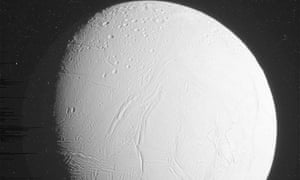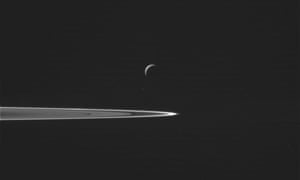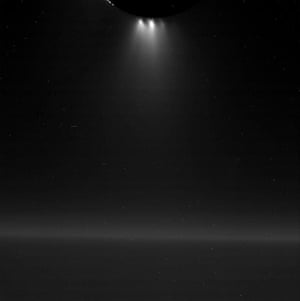Extract
from The
Guardian
Cassini spacecraft
images as it flew by Enceladus capture the grooved and cratered
surface of the moon, and the bright streaks of vapor plumes

This image shows
Saturn’s moon Enceladus as the Cassini spacecraft made a close
flyby of the icy moon. Photograph: AP
Alan
Yuhas in New York
Saturday
31 October 2015 05.08 AEDT
A Nasa spacecraft
that dived through a geyser plume on one of Saturn’s moons, closer
to the surface than ever before, has delivered the first images and
data from its “taste” of an underground ocean.
The
Cassini spacecraft made its lowest pass over Enceladus on
Wednesday, flying only 30 miles above the moon’s south pole and
through jets of freezing water vapour and other molecules erupting
from below ground.
Last
year researchers discovered
a deep saltwater ocean inside Enceladus, after seeing hints
of it in the jets of vapor first photographed in 2005. Cassini’s
lowest flyby should help them solve some of the moon’s mysteries,
including whether undersea vents heat the ocean – and whether that
ocean could support life a billion kilometres from Earth.
Images
taken by Cassini as it swept past Enceladus captured the pale,
grooved and cratered surface of the moon, and the bright streaks of
vapor plumes erupting from its south pole.

This
image shows Saturn’s moon Enceladus, center, as the Cassini
spacecraft prepared to make a close flyby of the icy moon. A portion
of the planet’s ring is at left. Photograph: AP“We know all of
the data from the Enceladus flyby has been successfully transmitted
to the ground and teams are now looking at that,” said Linda
Spilker, Cassini project scientist at Nasa’s Jet Propulsion Lab in
Pasadena, California. The probe’s measurements of the chemical
makeup of the plume are likely to take weeks to complete, she added.
“There’s
quite a variety of smoking guns we’re looking for here,”
said Paul
Helfenstein, a mission scientist and research associate at Cornell
Center for Astrophysics and Planetary Science.
A
sensor on board the spacecraft has “tasted the eruptions of vapor
and ice materials” and will identify any of the basic ingredients
of life, he said. After past, higher-altitude journeys through the
plume, Cassini has detected water vapor, methane, nitrogen, ammonia
and other molecules associated with life. But Wednesday’s pass was
the lowest ever, through a range more likely to hold heavier, more
complex organic molecules.
“Enceladus
is not just an ocean world, it’s a world that might provide a
habitable environment for life as we know it,” program scientist
Curt Niebur told reporters on Monday.
Helfenstein
and his cohorts are hunting in particular for hydrogen gas, which
would be an indirect measure of the reactions where Enceladus’
ocean and rocky core meet. Hydrogen would indicate hot vents at the
bottom of the ocean, of the same kind as vents that also appear in
Earth’s oceans and have habitable conditions for simple life. The
prospect of hydrothermal activity on Enceladus has made the tiny
world one of scientists’ best hopes for finding life
elsewhere.
Cassini
will also search for any hint of salt in the spray, a key clue to
both chemical reactions in the depths and how the ocean stays liquid
so far from the sun.
“For
the chemistry of life you’d need a source of heat that’s capable
of driving the chemical reactions,” Helfenstein said, as well as
the right temperature conditions and contact between the moon’s
ocean and rocky core.
Geysers
and fissures cover Enceladus in patterns called “tiger stripes”,
and Cassini has passed through a plume over the “Damascus” stripe
on Wednesday. There is evidence for more than 100 discrete geysers,
and the moon’s chemical plumes appear to spew from both individual
jets and curtain-like eruptions.
Scientists
believe an underground ocean of liquid water is the source of the
shooting jet stream. Photograph: AP“The spacing of the geysers on
the tiger stripes isn’t random,” Helfenstein said, and probably
determined by the force of Saturn’s gravity on the moon. The
gravity has a kneading effect, he said, pushing and pulling on the
moon with enough power to apparently generate heat and create the
regular geological patterns.Although Enceladus is tiny compared to
Earth – it could fit within
Arizona’s borders – its liquid ocean has made it a prime
suspect for the search for life, according to Nasa’s mantra:
“follow the water”. That imperative has guided researchers
to liquid
water on Mars, an underground
ocean on Jupiter’s moon Europa, and methane
lakes on Titan, another of Saturn’s moons.In December
Cassini will measure the temperature of Enceladus in a final flight
past the moon, more than 18 years after it launched from Earth and
more than a decade after it first entered orbit around Saturn.

No comments:
Post a Comment